Les Invalides
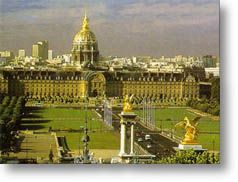
Les Invalides comprises the largest single collection/complex of monuments in Paris, including:
- Musee de l'Armee
- Musee des Plans-Reliefs
- Musee de l'Ordre de la Liberation
- L'Eglise de St-Louis-des-Invalides
The Hotel National des Invalides
In 1670, Louis the 14th decided to erect a building able to house disabled soldiers, or those too old to serve in his armies. The war minister, Louvois, was entrusted with the project, and he chose the architect Liberal Bruant for the construction of the hotel, the design of which is a reminder of the Escorial palace by Philippe II (Spain). This project was part of the social and charitable trend of the 17th century, and the Hotel des Invalides became an exemple to follow for many other European countries.

The construction of the military complex was over in 3 years only and the first residents entered as soon as October 1674. The life of the 4000 residents (end of the 17th century) was ruled in the same way as in barracks and monasteries. The soldiers were divided into companies and worked in workshops, making uniforms, shoes, tapestries and book illumination, so as to fight idleness.
The severely injured ones, about 100, were taken care of in the hospital, set in the South-east section. This hospital is still active today, whereas the pension for old soldiers around the courtyard now hosts the museum rooms.
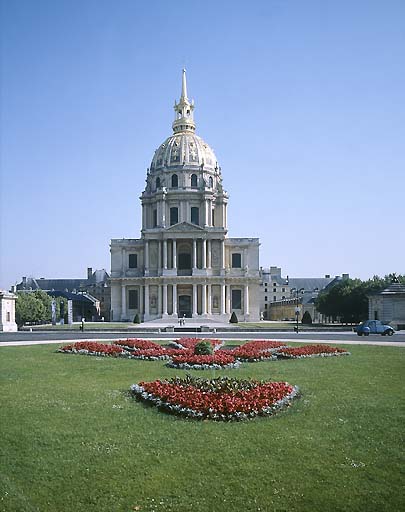
In 1676, the church project, in the south, was given to Jules Hardouin-Mansart, who built the great royal church, or Dome Church (using the blueprints of his great-uncle Francois Mansart). He also finished the church used by the residents for the daily cult, the Soldiers Church. The Dome Church is a masterpiece of French classical architecture; its decoration was given to the finest artists of Louis XIV (Charles de la Fosse, Jouvenent, Girardon) who also worked at Versailles. Reaching 101m at the top of the spire, it is a reference in the landscape of Paris, and was inaugurated on August 28th 1706 by the king.
Under Napoleon I, the Dome became the pantheon of France military glories, by housing the tomb of Turenne and the heart of Vauban.
In 1989, for the 200th anniversary of the French Revolution, the Dome was regilded for the 5th time since its creation; 550 000 gold leaves were used, that is to say more than 20 pounds.
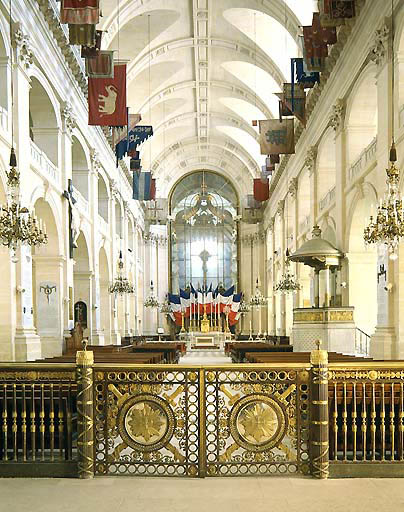
The Soldiers Church, also called "choir of the residents", was meant for the daily cult and services, and was over by 1679. The Church Saint Louis des Invalides, the vault of which was decorated with the military trophies of France, houses the governors crypt, where many governors of the Invalides, marshals of France and great military leaders lie.
Dedicated to Saint Louis and consecrated to the Holy Trinity , the Church is administratively attached to the Musee de l'Armee since its creation in 1905. It is now the French armies curacy see, and is used every year for commemorative masses, among which the anniversary mass for the death of Napoleon, on May 5th, and the anniversary mass for the founding of the Hotel, in September.
The great organs were designed between 1679 and 1687, and restored from 1955 to 1957. The case was made by Germain Pilon, the king carpenter, upon a drawing by Hardouin-Mansart.
Tombeau de Napoleon
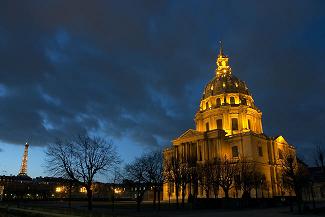
May 5, 1821 Napoleon Ier dies out in the island of Sainte-Helene where he had been exiled to since 1815. He is buried in the shade of some weeping willows. Its mortal remains remains there until October 15, 1840. It is in 1840 that was decided by king Louis-Philippe the transfer the remains of the body of the Emperor. French sailors, placed under the command of prince de Joinville, bring back to his coffin to France to edge of the ship "Belle Poule". A national funeral accompanies the return of the Emperor Napoleon Ier and his cremation, ashes transferred to the Invalides on December 15th 1840, while waiting for the construction from the tomb. This one is ordered in 1842 by king Louis-Philippe with the architect Visconti (1791-1853), who makes realize under the Dome of significant transformations by boring an immense excavation to accomodate the tomb. The body of the Emperor Napoleon Ier, is deposited there on April 2nd 1861. The tomb, worked in blocks of red bricks from Russia, placed on a green granite base of the Vosges, is encircled of a laurel wreath and inscriptions pointing out the great victories of the Empire. In the circular gallery, a succession of low-reliefs carved by Simart appear the principal actions of the reign. At the bottom of the crypt, above the flagstone under which the King of Rome rests, a statue of the Emperor is set up carrying imperial emblemes. The Church of the Dome shelters also the burials of two of the brothers of Napoleon, Jerome and Joseph Bonaparte, of his son, the Eaglet, like those, more recent, of the marshals Foch and Lyautey. The museum of the Army is responsible for these spaces.
The Musee de l'Armee
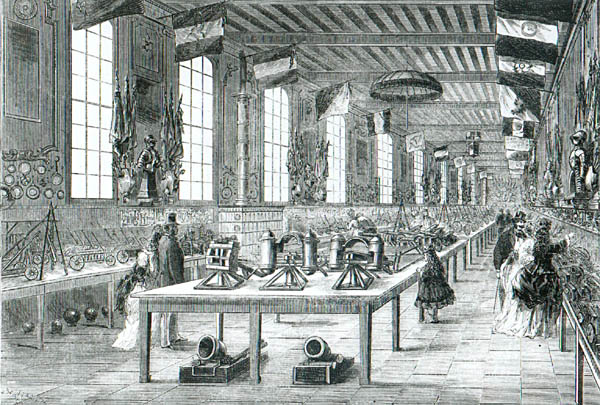
The Musee de l'Armee was created in 1905, by merging the Artillery Museum and the Historical Army Museum. It will celebrate its 100th birthday in 2005, with the reopening of the western wing, renovated under the ATHENA II project.
The Artillery Museum (created during the French Revolution and set in the Invalides in 1871) is, in itself, the heir of two of the most prestigious weapons collections : the collection of the "garde-meuble de la Couronne" and the Conde princes collections (Chantilly). From 1852, those two collections were placed in the Invalides, and enlarged with a series of collections coming, among others, from the Bibliotheque Nationale, the Louvre, the artillery in Vincennes, the Hotel des Monnaies, the Pierrefonds castle, and from numerous acquisitions made during the colonial campaigns, or due to private bequests.
The Historical Army Museum was founded in 1896, by a society named "la Sabretache", whose president , the painter Edouard Detaille, wanted to create, from his own collections, a national military museum, the way the retrospective rooms at the Universal Exhibition in Paris in 1889 had been set.
Among the most prestigious collections of the museum, one can list the "ancient weapons and armours" one (the 3rd one in the world), the "artillery scale-models" one (quite unique) and an exceptional ensemble of exhibits, from the 19th century, related to Napoleon I and the marshals of the Empire, amongst others.
The Musee de l'Armee places itself among the greatest art and military history museums in the world. Its situation, at the heart of a military purposed monument, such as the Hotel National des Invalides, offers an exceptional aspect. There are few military museums which can offer such a variety of exhibits and cover such large chronological periods.